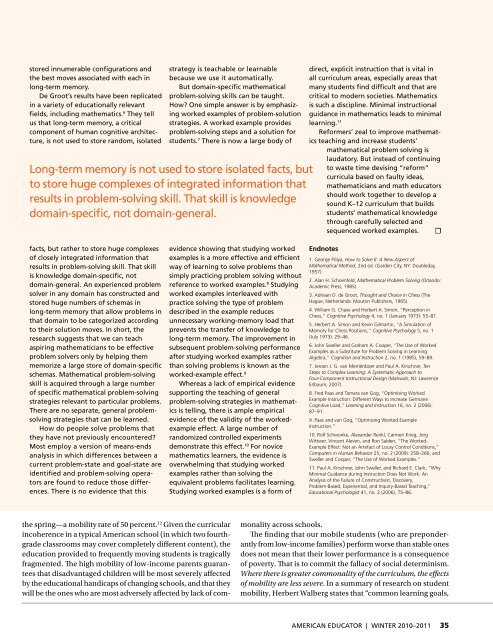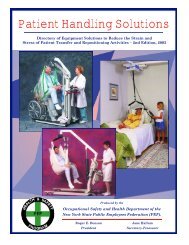American Educator, Winter 2010-11, Vol. 34, No. 4, AFT
American Educator, Winter 2010-11, Vol. 34, No. 4, AFT
American Educator, Winter 2010-11, Vol. 34, No. 4, AFT
You also want an ePaper? Increase the reach of your titles
YUMPU automatically turns print PDFs into web optimized ePapers that Google loves.
stored innumerable configurations and<br />
the best moves associated with each in<br />
long-term memory.<br />
De Groot’s results have been replicated<br />
in a variety of educationally relevant<br />
fields, including mathematics. 6 They tell<br />
us that long-term memory, a critical<br />
component of human cognitive architecture,<br />
is not used to store random, isolated<br />
facts, but rather to store huge complexes<br />
of closely integrated information that<br />
results in problem-solving skill. That skill<br />
is knowledge domain-specific, not<br />
domain-general. An experienced problem<br />
solver in any domain has constructed and<br />
stored huge numbers of schemas in<br />
long-term memory that allow problems in<br />
that domain to be categorized according<br />
to their solution moves. In short, the<br />
research suggests that we can teach<br />
aspiring mathematicians to be effective<br />
problem solvers only by helping them<br />
memorize a large store of domain-specific<br />
schemas. Mathematical problem-solving<br />
skill is acquired through a large number<br />
of specific mathematical problem-solving<br />
strategies relevant to particular problems.<br />
There are no separate, general problemsolving<br />
strategies that can be learned.<br />
How do people solve problems that<br />
they have not previously encountered?<br />
Most employ a version of means-ends<br />
analysis in which differences between a<br />
current problem-state and goal-state are<br />
identified and problem-solving operators<br />
are found to reduce those differences.<br />
There is no evidence that this<br />
strategy is teachable or learnable<br />
because we use it automatically.<br />
But domain-specific mathematical<br />
problem-solving skills can be taught.<br />
How? One simple answer is by emphasizing<br />
worked examples of problem-solution<br />
strategies. A worked example provides<br />
problem-solving steps and a solution for<br />
students. 7 There is now a large body of<br />
Long-term memory is not used to store isolated facts, but<br />
to store huge complexes of integrated information that<br />
results in problem-solving skill. That skill is knowledge<br />
domain-specific, not domain-general.<br />
the spring—a mobility rate of 50 percent. 12 Given the curricular<br />
incoherence in a typical <strong>American</strong> school (in which two fourthgrade<br />
classrooms may cover completely different content), the<br />
education provided to frequently moving students is tragically<br />
fragmented. The high mobility of low-income parents guarantees<br />
that disadvantaged children will be most severely affected<br />
by the educational handicaps of changing schools, and that they<br />
will be the ones who are most adversely affected by lack of com-<br />
evidence showing that studying worked<br />
examples is a more effective and efficient<br />
way of learning to solve problems than<br />
simply practicing problem solving without<br />
reference to worked examples. 8 Studying<br />
worked examples interleaved with<br />
practice solving the type of problem<br />
described in the example reduces<br />
unnecessary working-memory load that<br />
prevents the transfer of knowledge to<br />
long-term memory. The improvement in<br />
subsequent problem-solving performance<br />
after studying worked examples rather<br />
than solving problems is known as the<br />
worked-example effect. 9<br />
Whereas a lack of empirical evidence<br />
supporting the teaching of general<br />
problem-solving strategies in mathematics<br />
is telling, there is ample empirical<br />
evidence of the validity of the workedexample<br />
effect. A large number of<br />
randomized controlled experiments<br />
demonstrate this effect. 10 For novice<br />
mathematics learners, the evidence is<br />
overwhelming that studying worked<br />
examples rather than solving the<br />
equivalent problems facilitates learning.<br />
Studying worked examples is a form of<br />
direct, explicit instruction that is vital in<br />
all curriculum areas, especially areas that<br />
many students find difficult and that are<br />
critical to modern societies. Mathematics<br />
is such a discipline. Minimal instructional<br />
guidance in mathematics leads to minimal<br />
learning. <strong>11</strong><br />
Reformers’ zeal to improve mathematics<br />
teaching and increase students’<br />
mathematical problem solving is<br />
laudatory. But instead of continuing<br />
Endnotes<br />
to waste time devising “reform”<br />
curricula based on faulty ideas,<br />
mathematicians and math educators<br />
should work together to develop a<br />
sound K–12 curriculum that builds<br />
students’ mathematical knowledge<br />
through carefully selected and<br />
sequenced worked examples. ☐<br />
1. George Pólya, How to Solve It: A New Aspect of<br />
Mathematical Method, 2nd ed. (Garden City, NY: Doubleday,<br />
1957).<br />
2. Alan H. Schoenfeld, Mathematical Problem Solving (Orlando:<br />
Academic Press, 1985).<br />
3. Adriaan D. de Groot, Thought and Choice in Chess (The<br />
Hague, Netherlands: Mouton Publishers, 1965).<br />
4. William G. Chase and Herbert A. Simon, “Perception in<br />
Chess,” Cognitive Psychology 4, no. 1 (January 1973): 55–81.<br />
5. Herbert A. Simon and Kevin Gilmartin, “A Simulation of<br />
Memory for Chess Positions,” Cognitive Psychology 5, no. 1<br />
(July 1973): 29–46.<br />
6. John Sweller and Graham A. Cooper, “The Use of Worked<br />
Examples as a Substitute for Problem Solving in Learning<br />
Algebra,” Cognition and Instruction 2, no. 1 (1985), 59–89.<br />
7. Jeroen J. G. van Merriënboer and Paul A. Kirschner, Ten<br />
Steps to Complex Learning: A Systematic Approach to<br />
Four-Component Instructional Design (Mahwah, NJ: Lawrence<br />
Erlbaum, 2007).<br />
8. Fred Paas and Tamara van Gog, “Optimising Worked<br />
Example Instruction: Different Ways to Increase Germane<br />
Cognitive Load,” Learning and Instruction 16, no. 2 (2006):<br />
87–91.<br />
9. Paas and van Gog, “Optimising Worked Example<br />
Instruction.”<br />
10. Rolf Schwonke, Alexander Renkl, Carmen Krieg, Jorg<br />
Wittwer, Vincent Aleven, and Ron Salden, “The Worked-<br />
Example Effect: <strong>No</strong>t an Artefact of Lousy Control Conditions,”<br />
Computers in Human Behavior 25, no. 2 (2009): 258–266; and<br />
Sweller and Cooper, “The Use of Worked Examples.”<br />
<strong>11</strong>. Paul A. Kirschner, John Sweller, and Richard E. Clark, “Why<br />
Minimal Guidance during Instruction Does <strong>No</strong>t Work: An<br />
Analysis of the Failure of Constructivist, Discovery,<br />
Problem-Based, Experiential, and Inquiry-Based Teaching,”<br />
Educational Psychologist 41, no. 2 (2006), 75–86.<br />
monality across schools.<br />
The finding that our mobile students (who are preponderantly<br />
from low-income families) perform worse than stable ones<br />
does not mean that their lower performance is a consequence<br />
of poverty. That is to commit the fallacy of social determinism.<br />
Where there is greater commonality of the curriculum, the effects<br />
of mobility are less severe. In a summary of research on student<br />
mobility, Herbert Walberg states that “common learning goals,<br />
AMERICAN EDUCATOR | WINTER <strong>2010</strong>–20<strong>11</strong> 35





